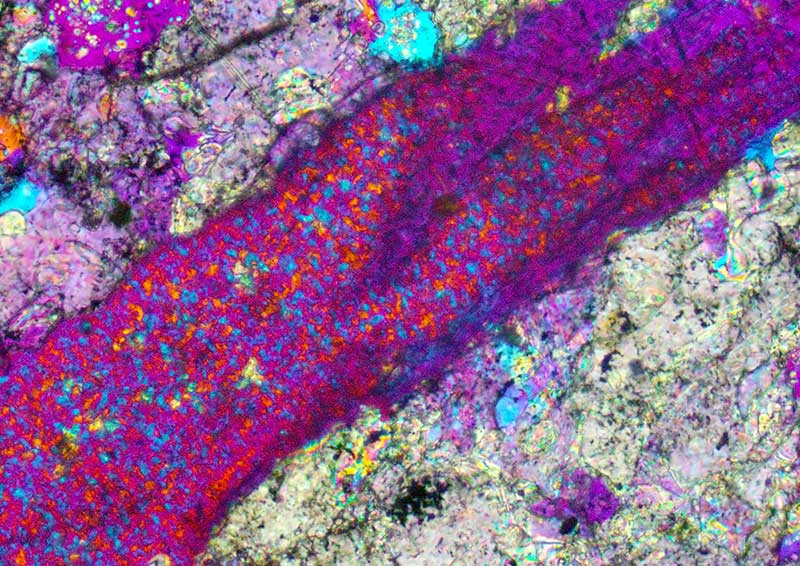Alkali-aggregate reaction (AAR)
(Microscopic view of crystalline AAR product in cracked aggregate from a concrete bridge (Leemann et al, 2016).)
[edit] Introduction
The dominance of Portland cement concrete as the world's pre-eminent structural material developed during the 19th century and continued throughout the 20th century and retains that position today.
However, the material had a 'guilty secret' that was only revealed by research in the USA during the 1930s. In some circumstances, an expansive reaction can gradually occur between aggregate constituents and alkaline hydroxides from the cement, causing damage to the hardened concrete within structures.
This has become known as 'alkali-aggregate reaction' (AAR), or most commonly and more specifically, 'alkali-silica reaction' (ASR). This AAR family of mechanisms is by no means the most frequently encountered threat to concrete durability or the serviceability of structures, but it can be a serious issue when it occurs.
It has continued to fascinate concrete research scientists and engineers ever since its first published description, some 76 years ago.
[edit] Getting to grips with AAR
Over more than 40 years, I have been privileged to witness practising engineers and applied scientists getting to grips with AAR worldwide. I believe we now understand the several reactions, including how to recognise them in existing structures and manage the situation, but crucially also including how to determine any possible AAR potential in new works and take effective precautionary measures.
However, challenges remain, especially as appreciation of the potential threat from AAR is not universally or equally appreciated everywhere in the world, and we are still finding types of structure that behave exceptionally. Overall, the prospects are encouraging for both a declining incidence of AAR damage and successful approaches to management and/or repair of affected cases.
This article was originally published by ICE on 30 June 2016. It was written by Simon Fullalove. You can see the original article here.
--The Institution of Civil Engineers
[edit] Related articles on Designing Buildings Wiki
Featured articles and news
The history of building regulations
A story of belated action in response to crisis.
Moisture, fire safety and emerging trends in living walls
How wet is your wall?
Current policy explained and newly published consultation by the UK and Welsh Governments.
British architecture 1919–39. Book review.
Conservation of listed prefabs in Moseley.
Energy industry calls for urgent reform.
Heritage staff wellbeing at work survey.
A five minute introduction.
50th Golden anniversary ECA Edmundson apprentice award
Showcasing the very best electrotechnical and engineering services for half a century.
Welsh government consults on HRBs and reg changes
Seeking feedback on a new regulatory regime and a broad range of issues.
CIOB Client Guide (2nd edition) March 2025
Free download covering statutory dutyholder roles under the Building Safety Act and much more.
AI and automation in 3D modelling and spatial design
Can almost half of design development tasks be automated?
Minister quizzed, as responsibility transfers to MHCLG and BSR publishes new building control guidance.
UK environmental regulations reform 2025
Amid wider new approaches to ensure regulators and regulation support growth.
The maintenance challenge of tenements.
BSRIA Statutory Compliance Inspection Checklist
BG80/2025 now significantly updated to include requirements related to important changes in legislation.
























